Psychoactive acacias
Jump to navigation
Jump to search
This is a list of Acacia species (sensu lato) that are known to contain psychoactive alkaloids, or are suspected of containing such alkaloids due to being psychoactive. The presence and constitution of alkaloids in nature can be highly variable, due to environmental and genetic factors.
| 0.04-0.82% alkaloids in leaves and stems, 0.08% in ripe pods, mostly phenethylamine[1] | |
| DMT in bark (up to 1.6%) and in leaves (0.6-1.0%), young leaves mainly containing tryptamine;[2] 0.72% alkaloids from leaves and stems, mostly tryptamine[3] | |
| DMT in bark (0.2-1.2%), 0.1% alkaloids from leaves (mostly NMT);[2] 1.5% alkaloids from leaves and stems, mostly tryptamine[3] | |
| β-methyl-phenethylamine (N-methyl-phenethylamine), 2.4% in leaves;[4] 3.2% alkaloids in aerial parts (stems, leaves, flowers) - about 70% was β-methyl-phenethylamine, with smaller amounts of phenethylamine[3] | |
| Published reports of DMT in the leaf[5] derive from a misreading of a paper that found no DMT in leaves of this species.[6] Besides this, there are independent claims of DMT in leaves and bark based on human bioassay,[2] and traces of 5-MeO-DMT, DMT and NMT were tentatively identified by TLC in twigs.[7] Root bark contains alkaloids that were not identified[8] | |
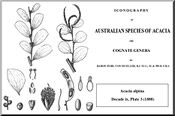 |
Dimethyltryptamine active levels in leaf[9] |
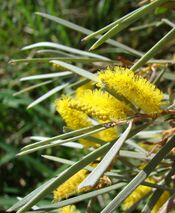 |
Ash used in Pituri.[10] Ether extracts about 2-6% of the dried leaf mass.[11] Not known if psychoactive per se. |
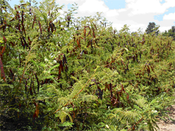 |
0.028% β-methyl-phenethylamine in leaves,[12] DMT (0.00012-0.00102%) and N-methyltyramine (0.00011-0.005%) in leaves;[13] DMT and 5-MeO-DMT tentatively identified by TLC from roots in one test, not detected in follow up; 5-MeO-DMT tentatively identified by TLC in seeds[7] |
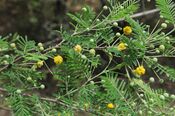 |
Has been claimed to contain tryptamine alkaloids[14] and significant amount of tryptamine in the seeds,[15] but this needs confirmation and supporting information |
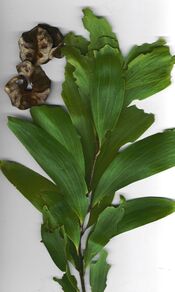 |
5-MeO-DMT tentatively identified in stem bark[7] |
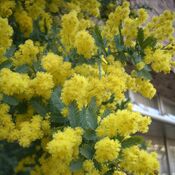 |
0.02% alkaloids in spring (80% tetrahydroharman, 20% tryptamine), 0.028% autumn (tryptamine) and none in summer, with leaves of Californian plants;[16] traces of DMT and unidentified indoles tentatively detected in seeds[7] |
| Claimed to be psychoactive,[17] but supporting information is needed. Ash used in pituri[10] | |
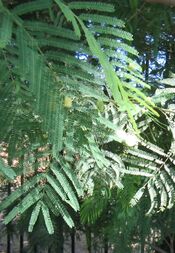 |
Hordenine, tyramine and N-methyltyramine in leaves;[18] 0.28-0.66% N-methylphenethylamine in leaves. Causes stock intoxications in Texas.[12][19] Claims of amphetamines, mescaline, nicotine and many other alkaloids[20] are suspect[21] |
| 0.65% alkaloids from leaves and stems, 0.58% from pods and 0.09% from seeds, mostly phenethylamine[1] | |
| Tryptamine and DMT N-oxide from bark[22] | |
| 0.02-0.06% alkaloids from stems and leaves, consisting of tryptamine and phenethylamine;[3] one screening found no alkaloids[23] | |
 |
Claims of DMT in the plant[24] have been referenced to works that do not support the claim. Needs research. |
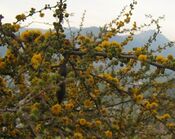 |
Claims of tryptamines in this species are unreferenced. Leaves of this (and/or other plants) and tobacco, are occasionally smoked with Anadenanthera seeds for psychoactive effects[25] |
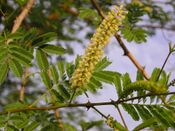 |
Claims of DMT and other tryptamines in leaf and bark are unreferenced. Needs research. |
| Claimed to contain up to 1.8% DMT in bark, 0.2-0.6% in leaf,[26] but others have found no alkaloids, or nearly none in this species[2] | |
| 0.3% N-methyl-tetrahydroharman, traces of tetrahydroharman in leaf and stem;[27][28] need confirmation | |
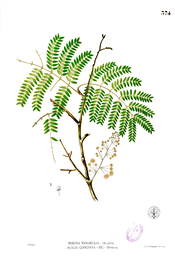 |
2.1% Nicotine (w/w), 1.2% calycotomine (d/w) from leaves[29][30] |
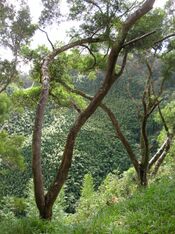 |
0.074% alkaloids from stems (20% DMT, 80% NMT);[31] NMT and an unidentified tryptamine alkaloid from trunk bark;[citation needed] 2.85% alkaloids from root bark (45% DMT, 55% NMT);[32] 0.005% DMT, 0.009% DMT N-oxide, 0.006% NMT and 0.007% N-chloromethyl-DMT (might be artefact of extraction) from unspecified parts[33] |
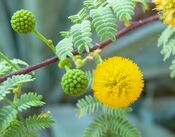 |
0.02% alkaloids from leaves, including β-methyl-phenethylamine (tentatively identified)[12] |
| Ash used in Pituri.[10][25] Not known if psychoactive. | |
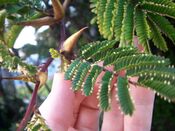 |
May be psychoactive, as the root is used as an aphrodisiac, and may have been added to the Central American balché beverage.[25] Claims of tryptamines in this species[34] might be speculation. Research needed. |
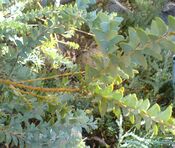 |
0.02-0.07% alkaloids in leaves and stems, including tryptamine (tentatively identified) and a phenethylamine. 0.04% alkaloids in seeds and unripe seed pods;[1][3][35] tentative observation of 5-MeO-DMT in leaves, stems and flowers[7] |
| Has been included on a list of psychoactive plants,[17] but requires supporting information | |
| Has been included on a list of psychoactive plants,[17] but requires supporting information | |
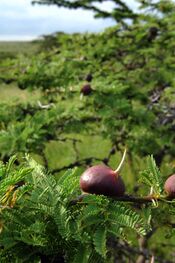 |
DMT in bark (up to 1.4%) and leaves (0.5-0.8%), young leaves mainly containing tryptamine[2] |
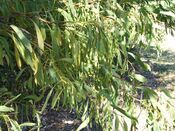 |
Psychoactive,[17] but less than 0.02% alkaloids[36] |
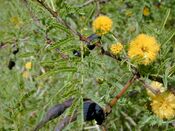 |
Tentative identification of 5-MeO-DMT and an unidentified β-carboline from immature seed pods;[7] tryptamine in stem bark.[22] A claim of β-methyl-phenethylamine from flowers is not supported by the reference given.[37] Ether extracts about 2-6% of the dried leaf mass.[11] Alkaloids are present in the bark[38] and leaves.[39] Others found no alkaloids.[23] Claims of amphetamines and mescaline in the tree[34] appear to be groundless |
| Has been added to pulque,[25] but its psychoactivity is unknown | |
| Up to 0.18% alkaloids from tops, mostly tryptamine with some phenethylamine; 0.15-1.18% alkaloids from flowers, equal amounts tryptamine and phenethylamine;[35][40] traces of unidentified alkaloid from bark.[1] Recently found to actually contain mostly DMT (up to 0.1% from leaves, 0.3-0.5% from bark), with bark also containing NMT, and small amounts of tryptamine, harman and norharman[2] | |
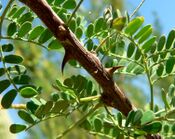 |
0.016% alkaloids from leaves, including (tentatively identified) N-methyl-β-phenethylamine and tyramine[12] |
| 0.1-0.6% alkaloids in leaves, consisting of phenethylamine and hordenine at a ratio of 2:3; 0.3% alkaloids in bark[4][23] | |
| Hordenine, 1.2% in bark[4] | |
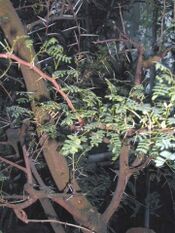 |
Has been claimed to be psychoactive, but this is not supported by the reference given[25] |
 |
Claimed to be psychoactive,[41] but this requires supporting information |
| Putative species claimed to contain DMT and NMT, without a reference; possibly assumed due to supposed use in jurema wine | |
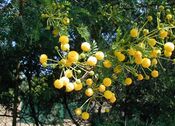 |
Probably psychoactive; roots used in Zimbabwe as an aphrodisiac and to treat dizziness, convulsions and body pains[42] |
| Used in Pituri, but not known if psychoactive.[25] | |
| 1.3-1.88% alkaloids from leaves and stems, mostly (92%) phenethylamine;[3] 0.9% β-methyl-phenethylamine from leaves[4] | |
| Published reports of DMT in the leaf[5] derive from a misreading of a paper that found no DMT in leaves of this species.[6] Needs research | |
| Tryptamine in root bark[22] | |
| Used in Pituri, but not known if psychoactive.[25] | |
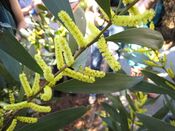 |
0.2-1% alkaloids from tops, 0.14-0.29% from flowers; consisted mostly of tryptamine-like alkaloids (tryptamine itself found in some flowers), with small amount of phenethylamine.[1][35][40] Some strains have been found to contain up to 0.2% DMT in unspecified parts.[2][43] Leaves, bark, pods, seeds and flowers all contained varying levels of histamine amides[44] |
| Contains alkaloids in leaves, stems and unripe seed pods[23][35] but they have been poorly investigated. A claim of tryptamine in leaveand bark[15] requires a proper reference. Several reports of DMT content unconfirmed[2] | |
| Claimed to contain tryptamine,[15] but without a reference. Needs research | |
| 0.13-0.71% alkaloids from bark, consisting of NMT and DMT in about a 2:3 ratio;[23][45] both also present in leaves. Some varieties of the species are not good alkaloid sources.[2] Tentative identification of 5-MeO-DMT in wood and twigs, NMT in root[7] | |
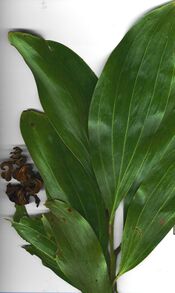 |
Rumoured to contain DMT or similar psychoactive alkaloids[2] |
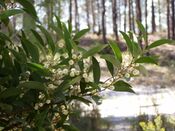 |
Some plants may contain DMT in the bark and leaf, but may have been misidentified as most do not.[2] Traces of alkaloids detected in bark, leaf and seed; sometimes no alkaloids[1][23] |
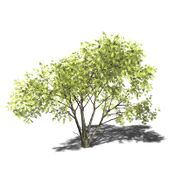 |
Published reports of DMT in the leaf[5] derive from a misreading of a paper that found no DMT in leaves of this species.[6] Needs research |
| DMT, NMT, tryptamine, other alkaloids[46] | |
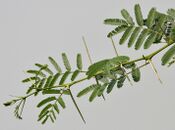 |
One ublished report of DMT in the leaf[5] may derive from a misreading of a paper that found no DMT in leaves of this species.[6] Later analysis tentatively found 5-MeO-DMT in stems, leaves and roots; DMT, NMT and 5-MeO-DMT were tentatively observed in seeds, but follow-up tests were negative.[7][47] Bark contains unidentified alkaloids[48] Bark in one sample subsequently found to contain an alkaloid which has an Rf value suggesting DMT. |
| DMT and Harmane derivatives[49] | |
| 0.15-0.6% alkaloids from bark, 0.07% from fresh tips,[2][23][50] 0.15-0.3% from dried leaves. A small population seems to contain mainly DMT in bark, with most also containing other alkaloids including NMT, tryptamine, harman and norharman; leaves may contain more NMT than DMT. Some assays showed tentative presence of 5-MeO-DMT and/or bufotenine but these are unconfirmed and other assays did not detect them[2][51][52] | |
| 0.016% DMT in leaf;[6] a claim of NMT in this species is unreferenced | |
| Claimed to be psychoactive,[17] but supporting information is needed. Bark and leaves have been used to poison fish[53] | |
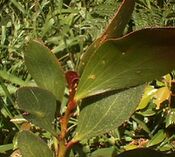 |
0.3% DMT in leaf;[54] a claim of NMT[9] could not be found in the reference given and needs verification. Species is rare and threatened |
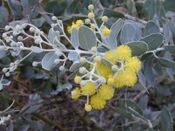 |
0.11-0.29% alkaloids in leaves and stems, 0.11% from seeds and pods, mostly tryptamine and sometimes with phenethylamine also present;[1][3][35] a later analysis found 0.06% tryptamine from leaves (w/w)[55] |
| 0.004%% DMT in leaf;[6] claims of NMT and other tryptamines in leaf and bark[56] are not supported by the reference given | |
| Up to 0.44% alkaloids from leaves and stems, mostly phenethylamine[35] | |
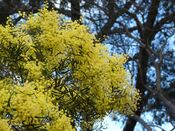 |
0.17-0.65% alkaloids from stems and leaves, 1.8% from flowering tops, consisting of phenethylamine and β-methyl-phenethylamine[1][3][35][57] |
| Ash used in Pituri.[10][25] Not known if psychoactive. | |
| 0.02-0.09% alkaloids from stems and leaves,[35] 0.04% from tops, mostly tryptamine with some phenethylamine[40] | |
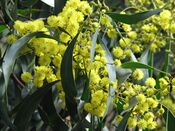 |
Less than 0.01% total alkaloids in leaf,[35] sometimes none.[23] 0.4% DMT in single tree[58] |
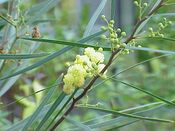 |
0.01% Nicotine was reported from leaves, but identity of the plant was not certain;[59] claims of DMT and NMT in the plant[60] require verification or a proper reference |
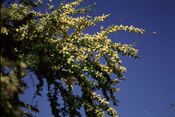 |
0.025% alkaloids from leaves, including N-methyl-phenethylamine and N-methyl-tyramine (both tentatively identified).[12] Claims of DMT, NMT, amphetamines, mescaline, nicotine and many other alkaloids[61] are suspect[21] |
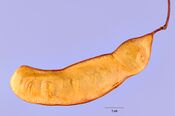 |
0.036% alkaloids from leaves, including β-methyl-phenethylamine, tyramine and N-methyl-tyramine[12] |
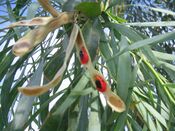 |
Ash used in Pituri.[10][25] Not known if psychoactive. |
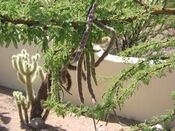 |
A claim of β-methyl-phenethylamine, phenethylamine, amphetamines and mescaline in this species[34] lacks a reference and is highly dubious |
| β-methyl-phenethylamine in leaves, tentatively identified[12] | |
 |
0.003% DMT in leaf;[6] claim of DMT in bark[15] requires verification |
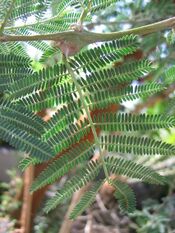 |
Published reports of DMT in the leaf[5] derive from a misreading of a paper that found no DMT in leaves of this species.[6] Ether extracts about 1-7% of the dried leaf mass.[11] |
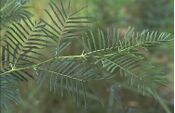 |
Published reports of DMT in the leaf[5] derive from a misreading of a paper that found no DMT in leaves of this species.[6] However it is rumoured that unpublished analysis has found DMT in the plant[2] |
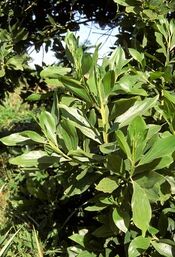 |
3.6% alkaloids from leaves and stem bark (40% NMT, 22.5% DMT, 12.7% 2-methyl-tetrahydro-β-carboline, and traces of N-formyl-NMT which might be an artefact of extraction)[62] |
| 0.21-0.35% alkaloids from leaves and stems, about 2/3 phenethylamine[3] | |
| Up to 0.89% alkaloids from leaves and stems, 0.05-0.17% from unripe pods, mostly phenethylamine[1][35] | |
| 0.008% alkaloids from leaves including β-methyl-phenethylamine and tyramine (tentatively identified)[12] | |
 |
Published reports of DMT in the leaf[5] derive from a misreading of a paper that found no DMT in leaves of this species.[6] Needs research |
| Tryptamine, in the leaf and stem (up to 83% of total alkaloids); alkaloid content was highest in autumn and spring (0.12-0.28%), lowest in summer and winter (0.03-0.08%)[3] | |
| Tentative positive for DMT in aerial parts of a 1 yr old plant, and 5-MeO-DMT in roots of 2 yr old seedlings;[7] a formal screening found no alkaloids in leaf and stem.[23] Appears to contain DMT based on human bioassays[2] |
Acacia species having little or no alkaloids in the material sampled[36]
Species containing a concentration of alkaloids of 0-0.02% include:
- Acacia acinacea
- Acacia baileyana
- Acacia decurrens
- Acacia dealbata
- Acacia mearnsii
- Acacia drummondii
- Acacia elata
- Acacia falcata
- Acacia leprosa
- Acacia linearis
- Acacia melanoxylon
- Acacia retinodes
- Acacia saligna
- Acacia stricta
- Acacia verticillata
- Acacia vestita
External links
- List of Acacia species known to contain psychoactive alkaloids (Wikipedia)
- Acacia spp. (Erowid Vault)
References
- ↑ 1.0 1.1 1.2 1.3 1.4 1.5 1.6 1.7 1.8 White, E.P. 1951. “Legumes examined for alkaloids – additions and corrections.” New Zealand J. Sci. & Tech. 33B:54-60.
- ↑ 2.00 2.01 2.02 2.03 2.04 2.05 2.06 2.07 2.08 2.09 2.10 2.11 2.12 2.13 2.14 independent assay
- ↑ 3.0 3.1 3.2 3.3 3.4 3.5 3.6 3.7 3.8 3.9 White, E.P. 1957. “Evaluation of further legumes, mainly Lupinus and Acacia species for alkaloids.” New Zealand J. Sci. & Tech. 38B:718-725.
- ↑ 4.0 4.1 4.2 4.3 Fitzgerald, J. (1964). "Alkaloids of the Australian Leguminosae. III. The occurrence of phenylethylamine derivatives in Acacia species". Australian Journal of Chemistry. 17 (1): 160. doi:10.1071/CH9640160. ISSN 0004-9425.
- ↑ 5.0 5.1 5.2 5.3 5.4 5.5 5.6 Shulgin, A. T., Shulgin, A. (1997). Tihkal: the continuation. Transform. ISBN 9780963009692.
- ↑ 6.0 6.1 6.2 6.3 6.4 6.5 6.6 6.7 6.8 6.9 Wahba Khalil, S. K., Elkheir, Y. M. (April 1975). "Dimethyltryptamine from the leaves of certain Acacia species of northern Sudan". Lloydia. 38 (2): 176–177. ISSN 0024-5461.
- ↑ 7.0 7.1 7.2 7.3 7.4 7.5 7.6 7.7 7.8 Keeper, T., Friends (2007). Some Simple Tryptamines (2nd ed.).
- ↑ Salisu, Y., Agunu, A., Ibrahim, G. (2009). "Hypoglycaemic effects of Acacia albida Del. (Mimosaceae) methanol root bark extract" (PDF). Nig. Journ. Pharm. Sci. 8 (1): 66–72.
- ↑ 9.0 9.1 Shaman Australis
- ↑ 10.0 10.1 10.2 10.3 10.4 Duboisia hopwoodii - Pituri Bush - Solanaceae - Central America
- ↑ 11.0 11.1 11.2 Wattle Seed Workshop Proceedings 12 March 2002, Canberra March 2003 RIRDC Publication No 03/024, RIRDC Project No WS012-06[dead link]
- ↑ 12.0 12.1 12.2 12.3 12.4 12.5 12.6 12.7 Camp, B. J., Norvell, M. J. (July 1966). "The phenylethylamine alkaloids of native range plants". Economic Botany. 20 (3): 274–278. doi:10.1007/BF02904278. ISSN 0013-0001.
- ↑ McSweeney, C. S., Gough, J., Conlan, L. L., Hegarty, M. P., Palmer, B., Krause, D. O. (June 2005). "Nutritive value assessment of the tropical shrub legume Acacia angustissima: Anti-nutritional compounds and in vitro digestibility". Animal Feed Science and Technology. 121 (1–2): 175–190. doi:10.1016/j.anifeedsci.2005.02.017. ISSN 0377-8401.
- ↑ Maya Ethnobotanicals[dead link]
- ↑ 15.0 15.1 15.2 15.3 Akacje (in Polish)
- ↑ Repke, D. B., Mandell, D. M., Thomas, J. H. (June 1973). "Alkaloids of Acacia baileyana". Lloydia. 36 (2): 211–213. ISSN 0024-5461.
- ↑ 17.0 17.1 17.2 17.3 17.4 www.bushfood.net
- ↑ Adams, H. R., Camp, B. J. (August 1966). "`The isolation and identification of three alkaloids from Acacia Berlandieri". Toxicon. 4 (2): 85–90. doi:10.1016/0041-0101(66)90002-X. ISSN 0041-0101.
- ↑ Camp, B. J., Moore, J. A. (March 1960). "A Quantitative Method for the Alkaloid of Acacia berlandieri**Received August 21, 1959, from the Department of Biochemistry and Nutrition, Texas Agricultural Experiment Station, College Station". Journal of the American Pharmaceutical Association (Scientific ed.). 49 (3): 158–160. doi:10.1002/jps.3030490309. ISSN 0095-9553.
- ↑ Clement, B. A., Goff, C. M., Forbes, T. D. A. (September 1997). "Toxic amines and alkaloids from Acacia berlandieri". Phytochemistry. 46 (2): 249–254. doi:10.1016/S0031-9422(97)00240-9. ISSN 0031-9422.
- ↑ 21.0 21.1 Ask Dr. Shulgin Online September 26, 2001
- ↑ 22.0 22.1 22.2 Ghosal, S. (March 1972). "OCCURRENCE OF PSYCHODELIC SUBSTANCES IN SOME INDIAN MEDICINAL PLANTS". Planta Medica. 21 (02): 200–209. doi:10.1055/s-0028-1099544. ISSN 0032-0943.
- ↑ 23.0 23.1 23.2 23.3 23.4 23.5 23.6 23.7 23.8 Collins, D. J., Culvenor, C. C. J., Lamberton, J. A., Loder, J. W., Price, J. R. (1 January 1990). Plants for Medicines: A Chemical and Pharmacological Survey of Plants in the Australian Region. Csiro Publishing. ISBN 9780643102743.
- ↑ Crowley, M. Secret Drugs of Buddhism.
- ↑ 25.0 25.1 25.2 25.3 25.4 25.5 25.6 25.7 25.8 Rätsch, C. (2005). The encyclopedia of psychoactive plants: ethnopharmacology and its applications. Park Street Press. ISBN 9780892819782.
- ↑ Dr Karl’s Q&A forum
- ↑ Johns, S. R., Lamberton, J. A., Sioumis, A. A. (1966). "Alkaloids of the Australian leguminosae. 7. Nb-methyltetrahydroharman from Acadia complanata A.Cunn. ex Benth".
- ↑ Acacia Complanata Phytochemical Studies
- ↑ Gupta, G., Nigam, S. (October 1970). "CHEMICAL EXAMINATION OF THE LEAVES OF ACACIA CONCINNA". Planta Medica. 18 (05): 55–62. doi:10.1055/s-0028-1099805. ISSN 0032-0943.
- ↑ SBEPL
- ↑ Arthur, H. R., Loo, S. N., Lamberton, J. A. (1967). "Nb-methylated trytamines and other constituents of Acacia confusa Merr. of Hong Kong".
- ↑ Liu, K.-C. et al. 1977. “Studies on the constituents of the cortex radicis of Acacia confusa.” Chemistry (The Chinese Chemical Society, Taiwan) 1:15-16.
- ↑ Buchanan, M. S., Carroll, A. R., Pass, D., Quinn, R. J. (April 2007). "NMR spectral assignments of a new chlorotryptamine alkaloid and its analogues fromAcacia confusa". Magnetic Resonance in Chemistry. 45 (4): 359–361. doi:10.1002/mrc.1959. ISSN 0749-1581.
- ↑ 34.0 34.1 34.2 Naturheilpraxis Fachforum (German)[dead link]
- ↑ 35.0 35.1 35.2 35.3 35.4 35.5 35.6 35.7 35.8 35.9 White, E.P. 1944a. “Isolation of β-phenethylamine from Acacia species.” New Zealand J. Sci. & Tech. 25B:139-142.
- ↑ 36.0 36.1 Hegnauer, R. (30 July 1996). Chemotaxonomie der Pflanzen: Band XIb-1: Leguminosae Teil 2: Caesalpinioideae und Mimosoideae. Springer Science & Business Media. ISBN 9783764351656.
- ↑ Dr. Duke's Phytochemical and Ethnobotanical Databases
- ↑ www.bpi.da.gov.ph
- ↑ Acacia farnesiana
- ↑ 40.0 40.1 40.2 White, E.P. 1944b. “Isolation of tryptamine from some Acacia species.” New Zealand J. Sci. & Tech. 25B:157-162.
- ↑ Lista över hallucinogena växter, svampar och djur - Magiska Molekylers Wiki (in Swedish)
- ↑ Stafford, G. I., Pedersen, M. E., Staden, J. van, Jäger, A. K. (October 2008). "Review on plants with CNS-effects used in traditional South African medicine against mental diseases". Journal of Ethnopharmacology. 119 (3): 513–537. doi:10.1016/j.jep.2008.08.010. ISSN 0378-8741.
- ↑ Lycaeum Acacia longifolia Template:WebCite
- ↑ Repke, D. B. (April 1975). "The histamine amides of Acacia longifolia". Lloydia. 38 (2): 101–105. ISSN 0024-5461.
- ↑ Fitzgerald, J., Sioumis, A. (1965). "Alkaloids of the Australian Leguminosae. V. The occurrence of methylated tryptamines in Acacia maidenii F. Muell". Australian Journal of Chemistry. 18 (3): 433. doi:10.1071/CH9650433. ISSN 0004-9425.
- ↑ Baker, G. (2009). "Garden of Eden: The Shamanic Use of Psychoactive Flora and Fauna and the Study of Consciousness [Book Review]".
- ↑ Heffter, B. 1996. "Ask Barney" column. Crash Collusion magazine 8:39-43. Berkeley, California.
- ↑ Banso, A. (28 February 2009). "Phytochemical and antibacterial investigation of bark extracts of Acacia nilotica". Journal of Medicinal Plants Research. 3 (2): 082–085. doi:10.5897/JMPR.9000985. ISSN 1996-0875.
- ↑ Oliver-Bever, B. (23 January 1986). Medicinal Plants in Tropical West Africa. Cambridge University Press. ISBN 9780521268158.
- ↑ Acacia obtusifolia Phytochemical Studies
- ↑ Mulga. 2005. "HPLC-MS analysis of Acacia obtusifolia." The Entheogen Review 14(1):113-115.
- ↑ Trout, K. 2005. "Some thoughts on analysis and comparisons of extracts and synthetic DMT." The Entheogen review 14(1):116-118.
- ↑ Hurst, E. (1942). The poison plants of New South Wales. Printed by the Snelling Printing Works Pty. Ltd. for the New South Wales Poison Plants Committee.
- ↑ Rovelli, B., Vaughan, G. N. (3 September 2006). "Alkaloids of Acacia. I. NbNb-Dimethyltryptamine in Acacia phlebophylla F. Muell". Australian Journal of Chemistry. 20 (6): 1299. doi:10.1071/CH9671299.
- ↑ Balandrin, M. F., Kinghorn, A. D., Smolenski, S. J., Dobberstein, R. H. (September 1978). "Reversed-phase high-pressure liquid chromatography of some tryptamine derivatives". Journal of Chromatography A. 157: 365–370. doi:10.1016/S0021-9673(00)92354-9. ISSN 0021-9673.
- ↑ Hortipedia
- ↑ White, E.P. 1954. “The occurrence of N-methyl-β-phenylethylamine in Acacia prominens A. Cunn.” New Zealand J. Sci. & Tech. 35B:451-455.
- ↑ Nen. Talk at Intra Cortex 2002 Doon Doon, NSW
- ↑ Fikenscher, L. H. (16 April 1960). "[The occurrence of nicotine in the genus Acacia]". Pharmaceutisch Weekblad. 95: 233–235. ISSN 0031-6911.
- ↑ Pflanzentabelle APB (German)
- ↑ Clement, B. A., Goff, C. M., Forbes, T. D. A. (November 1998). "Toxic amines and alkaloids from acacia rigidula". Phytochemistry. 49 (5): 1377–1380. doi:10.1016/S0031-9422(97)01022-4. ISSN 0031-9422.
- ↑ Poupat, C. et al. 1976. “Alcaloïdes de Acacia simplicifolia.” Phytochemistry 15:2019-2020.